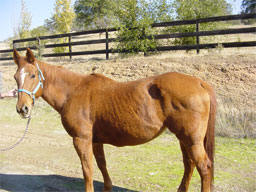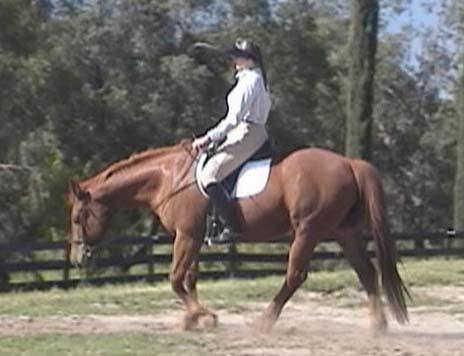| Amy's Page
I found Amy in 1999 as a
green broke 9 year old named Fred who had had very little
training. Her previous owner had been in an accident with her
and as a result, was afraid to ride her. I was drawn to Amy by
her gentle nature and powerful, balanced build.

In spite of her wonderful
disposition, Amy’s training went progressively downhill.
The first problem I noticed
was saddle fit. Amy had a broad back but high withers that tied
in toward the middle of her back. Saddles that had plenty of
clearance in the gullet at the pommel would still rub her
withers toward the center of the saddle.

I went through countless
saddles before I finally broke down and had one custom made for
her. Amy’s movement improved considerably with the new saddle
but she was still holding tension and progressively became more
unhappy contact. She eventually became a hopelessly evasive
snaky wiggle worm. Amy had passed her prepurchase exam with
flying colors but I had her teeth and hocks rechecked by a
different veterinarian anyway. A third veterinarian likewise
could not find anything wrong with Amy’s teeth or hocks but
after watching Amy move and palpating her neck, she suspected
that Amy had had a serious neck injury and recommended that I
take her to Davis for x-rays. The x-rays revealed moderate
arthritis in two places in Amy’s neck. The Doctors said that at
one time Amy must have been in some kind of fall where she had
landed on her neck. They also said what I had most dreaded to
hear – that "dressage" work and "collection" would most likely
do more damage to Amy's neck in the long run due to the neck
contortions and "headset" now commonly associated with dressage.
I contacted Amy’s previous owner and asked her if she knew how
Amy had gotten hurt. As it turned out, she and Amy had taken a
summersault but the previous owner had no idea that Amy had been
injured because she herself had been knocked unconscious and
broke her arm and had not ridden Amy since. When the previous
owner found out that Amy was no longer able to be a riding horse
she agreed to buy Amy back as a broodmare.
There is a saying that once
you sell a horse you should never go back to see it. Well, after
three months I went to visit Amy and when I saw her I just HAD
to buy her back. I got my trailer and check book and brought her
home with the intent on retiring her to pasture.

Amy stood in pasture for
almost two years until one day I needed to prepare for an
upcoming clinic.

I planned on just riding
Amy around on the buckle but she had punctured her cheek right
where the cheek piece of the bridle would go. I ended up having
to ride her in her halter. As it turns out, the small puncture
was a blessing in disguise! Amy allowed me to pick up a steady
contact with the reins attached to the halter.

I had moved to a new area
(another blessing in disguise) and subsequently discovered a
wonderful veterinarian, Dr. Betty Nunes, DVM. I asked Dr. Nunes
over the phone why Amy’s arthritis would be a problem with a
bridle but not a halter. She said that Amy’s reaction sounded
more like a response to dental problems than a response to
the arthritis in her neck. Sure enough, when the Doctor examined
Amy's mouth she found a number of sharp points which had
previously gone undetected.
She also noticed that a bit would cause Amy’s excessively thick
lips to moosh into the rough surface on the front edges of her
teeth so the Doctor gave Amy bit seats.
Dr. Nunes also recommended changing Amy’s hoof angles. A
slightly more upright angle made breaking over easier for Amy
and relieved her neck.
The arthritis is still there but because the classical approach
to dressage allows the horse its natural, balance-based head and
neck carriage (as opposed to the popular trend of forcing the
horse’s neck into unnatural positions), dressage can be
practiced without damaging her neck further.

It has taken several months
to regain Amy’s trust in contact but she now confidently offers
contact and is progressing by leaps and bounds!
May 2008
Amy was taken to U.C. Davis
after repeated bouts of colic and diagnosed with a very serious
ulcer. After 3 months of medication and hand walking, Amy made a
full recovery.
Amy is now helping to
demonstrate some classical concepts in video. Here is her first
endeavor:
http://www.ridingart.com/energy_flow.htm
September 2008
Now that Amy is
comfortable, she can transition smoothly from 'walk on the
buckle' to contact.
Click on the photo below
to play video (or click here )

Amy is now moving more
freely and relaxed than ever and we finally have a solid
foundation on which to build.
Click on the photo below to see a video sample of Amy starting
back into work (or click here)

July 2009
Transitions from Medium Walk to Free Walk to Medium Walk.
Click on the photo below to see video of walk transitions (or
click here).

Notice, when watching this video, that Amy is relaxed and
working throughout her body. The contact remains neutral. My
elbows follow the motion of the bit. Amy's head position
is natural. There is no backward, 'sawing' action or downward
pressure on the bit to 'get her head down'. Amy's acceptance of
the contact is a result of relaxation, rhythm, alignment and
energy flow.
August 2009
Amy has been getting more and more uncomfortable with contact.
She also had sores in her ears due to fly gnats and was shaking
her ears quite a bit. The vet was out and was able to get Amy
comfortable again.

September 2009
Amy seems more comfortable than ever and is progressing nicely
again. Video of her most recent work can be seen by
clicking on the filmstrip below:


|

![]()